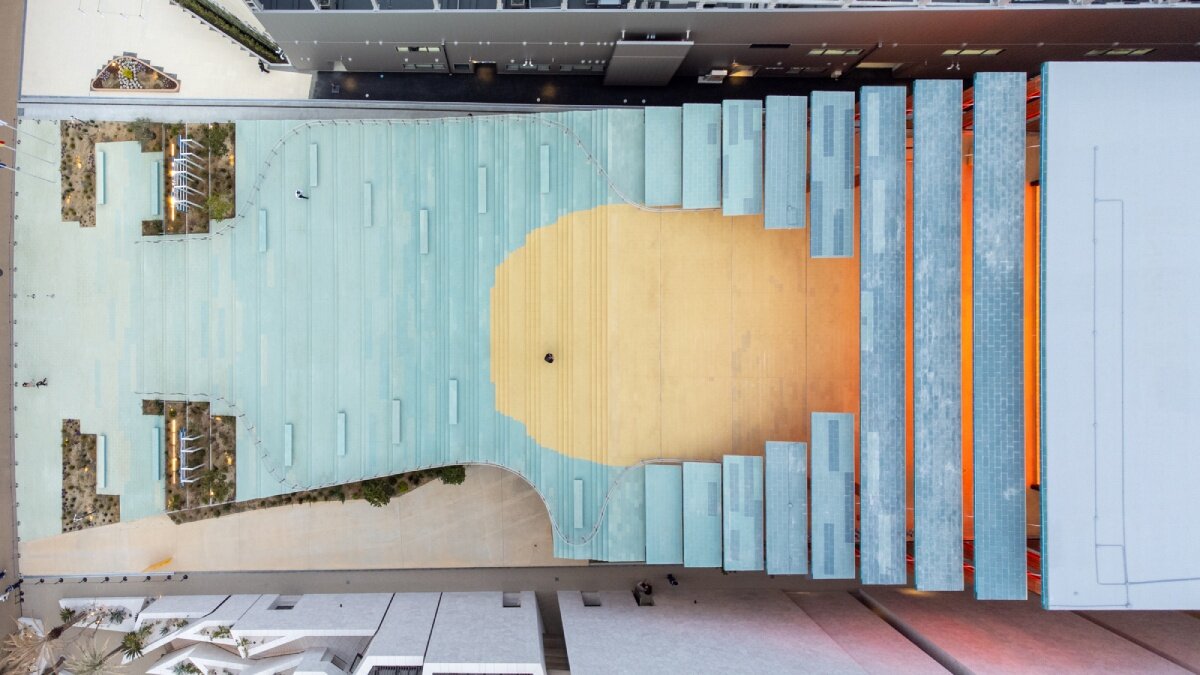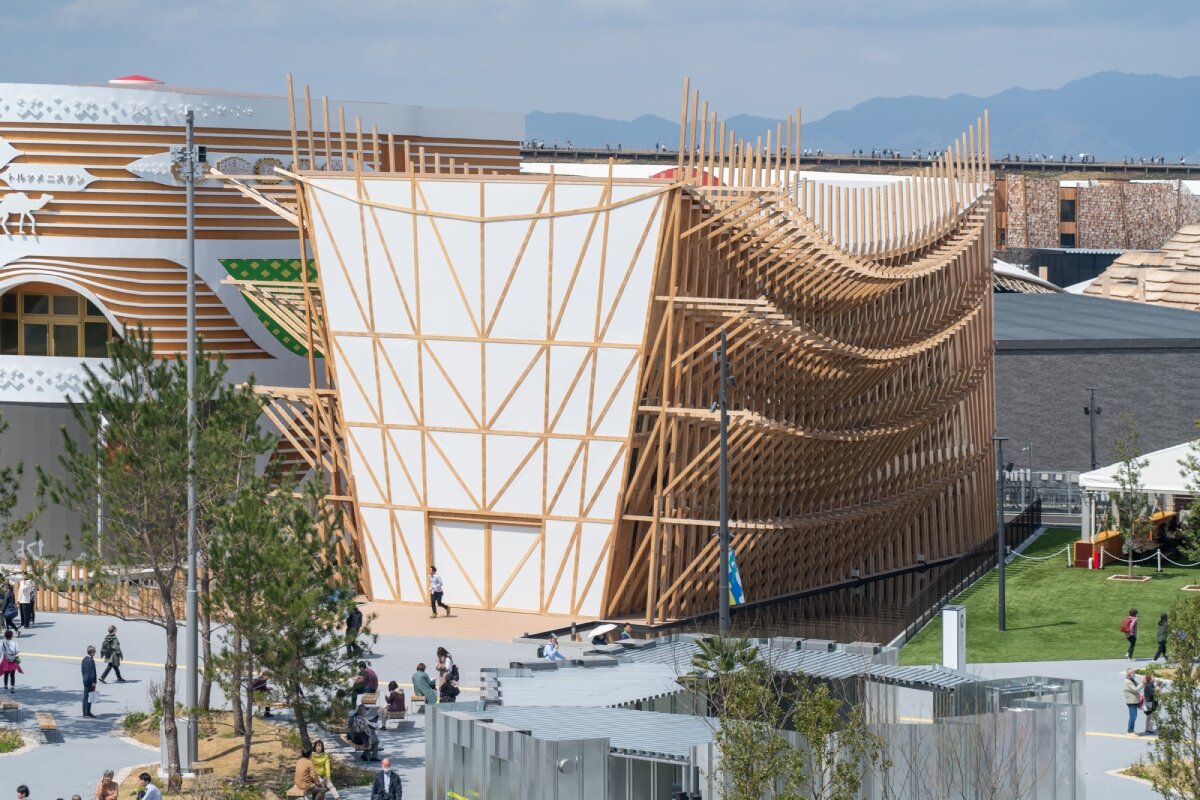a closer look inside expo 2025 osaka
Photographer William Mulvihill takes us around Japan’s Expo 2025 Osaka, capturing a cross-section of some of the most striking pavilions. These national identities take architectural form in varied ways, from expressive timber structures and modular wooden grids to immersive spatial choreographies and recycled rope facades — each responding to the Expo’s overarching theme: Designing Future Society for Our Lives.
Several nations revisit maritime heritage, like Bahrain’s dhow-like timber structure, Portugal’s suspended rope facade, while the UAE turns to the idea of reusing agricultural waste together with Japanese joinery. Others lean into circularity and adaptability, such as the Nordic Pavilion, designed for full disassembly, and Uzbekistan’s pavilion, which will be rebuilt back home after the Expo. Meanwhile France, Italy, and Saudi Arabia explore multi-sensory experiences that blend nature and technology. Explore the series below, and learn more about the Expo through designboom’s guide.

all images by William Mulvihill
oceans and the sun inspire spanish and belgian pavilions
The Spanish Pavilion by Enorme Studio, Smart and Green Design, and Néstor Montenegro Mateos draws on the shared presence of the ocean and the sun, linking the geographies of Spain and Japan through the Kuroshio Current This powerful, invisible ocean stream that has long connected the two nations becomes the focal point of the concept, which William Mulvihill captures from various vantage points. As the building’s architecture is shaped by these twin forces, it reflects a way of life rooted in marine navigation, solar rhythms, and cultural exchange. The exhibition narrative, centered on this east–west oceanic thread, presents the current as a medium of connection and continuity.
Water is also the central metaphor in the Belgium Pavilion by Carré 7, Beyond Limits, One Designs, Pirnay, and Poly-Tech. It organizes its structure across three levels representing the states of water: solid, liquid, and gas, and each layer corresponds to a different phase, using material expression and spatial design to evoke the properties of transformation and flow. Inside, the exhibition showcases innovations in life sciences and health care, with a focus on human-centered technologies.

Spanish Pavilion
serbia and monaco contemplate ideas of transformation
The Serbia Pavilion, titled Floating Forest, is inspired by a unique natural formation in Belgrade where a wooded island meets the city at the confluence of two major rivers. The design forms a spatial metaphor for balance between nature and urbanity, heritage and innovation. Its theme, Society of Play, weaves together scientific achievement, cultural production, and creative freedom. As a preview of Expo 2027 Belgrade, the pavilion at Expo 2025 Osaka positions Serbia as a host-in-waiting as well as an architectural manifestation of curiosity and care.
Under the theme Take Care of Wonder, the Monaco Pavilion, invites visitors into a multisensory exploration of environmental awareness. The design fosters a contemplative relationship with the natural world, and outdoor and indoor spaces are organized to elicit a sense of fragile beauty and ecological interdependence, encouraging visitors to reconsider the ties between self and planet. Alongside the exhibitions, a wine bar presents an experience of hospitality, offering wines and cognacs from the Hôtel de Paris Monte-Carlo’s renowned cellar. In this balance of spectacle and intimacy, the pavilion reflects Monaco’s broader message that care for the planet begins with the cultivation of wonder.

the architecture reflects a way of life rooted in marine navigation, solar rhythms, and cultural exchange
uae and bahrain explore material and cultural heritage
William Mulvihill captures how a few of the Gulf nations at Expo 2025 Osaka interpret sustainability through material heritage and cross-cultural exchange. UAE draws from Emirati building traditions while integrating Japanese wooden construction techniques. Designed with elements such as palm gravel — an agricultural byproduct — the pavilion reflects a commitment to low-impact materials and echoes a broader ambition to reconcile past practices with future challenges. Its layered approach emphasizes continuity with the landscape and offers a reinterpretation of traditional methods for a contemporary, climate-conscious context.
Designed by Lina Ghotmeh, the Bahrain Pavilion roots its concept in material and heritage. A timber structure reminiscent of traditional dhow boats faces the sea, symbolizing the island nation’s history as a maritime crossroads in the Gulf. Clad in aluminum and shaped using boat-building techniques, the structure draws from both local traditions and Japanese woodcraft. While passive cooling strategies address the Expo’s environmental demands, the design also marks a cultural convergence, positioning craft, sustainability, and diplomacy as interconnected concerns. Nearby, Saudi Arabia’s pavilion by Foster + Partners offers a more urban response, weaving native materials and computational design to evoke a sensory landscape of the Kingdom, reinforcing how regional architecture is increasingly aligned with climate performance and cultural storytelling.

Lina Ghotmeh’s Bahrain Pavilion
uzbekistan and nordic countries rethink wooden construction
The Nordic and Uzbekistan pavilions take Expo 2025 Osaka as an opportunity to foreground circularity and reusability in architecture with their intricate wooden structures. Designed by AMDL Circle, the Nordic Pavilion brings together Denmark, Finland, Iceland, Norway, and Sweden under a single structure made from forest-managed wood. Treated with natural oils and pigments, the dark-hued exterior draws from traditional preservation techniques, while the modular system allows for full disassembly and reuse after the event. Inside, an open-plan layout hosts exhibitions on regional sustainability innovations, while an outdoor terrace encourages informal exchange and rest.
The Uzbekistan Pavilion, designed by ATELIER BRÜCKNER and NUSSLI, adopts somewhat similar modular logic, built from a kit of prefabricated wooden elements, the pavilion is designed to be relocated after the Expo and reassembled in Uzbekistan as a workshop, school, or cultural space. William Mulvihill winds through its intricate spatial layout that unfolds through a garden, a forest of slender wooden columns, and a central sculpture, with each element symbolizing aspects of the country’s natural and creative identity.

a timber structure reminiscent of traditional dhow boats faces the sea
conceptual storytelling define italy and portugal’s pavilions
Both Italy and Portugal use architectural storytelling to frame questions of social connection, shared history, and environmental futures. Mario Cucinella Architects’ Italian Pavilion reinterprets the Renaissance ideal of the Città Ideale as a flexible, civic environment. The structure reveals a collection of public spaces such as a piazza, teatro, and giardino, with each inviting interaction, gathering, and cultural programming. Rooted in traditions of Italian urbanism, the design prioritizes modularity and openness, with adaptable spaces that also host the Holy See, creating a hybrid venue for art exhibitions, performances, and dialogue.
Kengo Kuma’s Portugal Pavilion takes a lighter, more elemental, yet sculptural approach. William Mulvihill captures the facade’s intricate suspended ropes and recycled fishing nets that recall ocean waves and nod to the country’s maritime legacy. Under the theme Ocean: The Blue Dialogue, the pavilion houses two exhibitions: one tracing Portugal’s longstanding maritime connection with Japan, and another envisioning a sustainable future through digital storytelling and immersive environments. The structure’s materials and assembly foreground a circular economy mindset, while its symbolic language reflects a deep engagement with climate, ecology, and shared stewardship of the sea. The France Pavilion by Coldefy and CRA-Carlo Ratti Associati offers a similarly immersive journey, staged as a three-act theatrical encounter with nature, further reinforcing how many of this year’s pavilions use movement and narrative structure to spatialize national values.


AloJapan.com